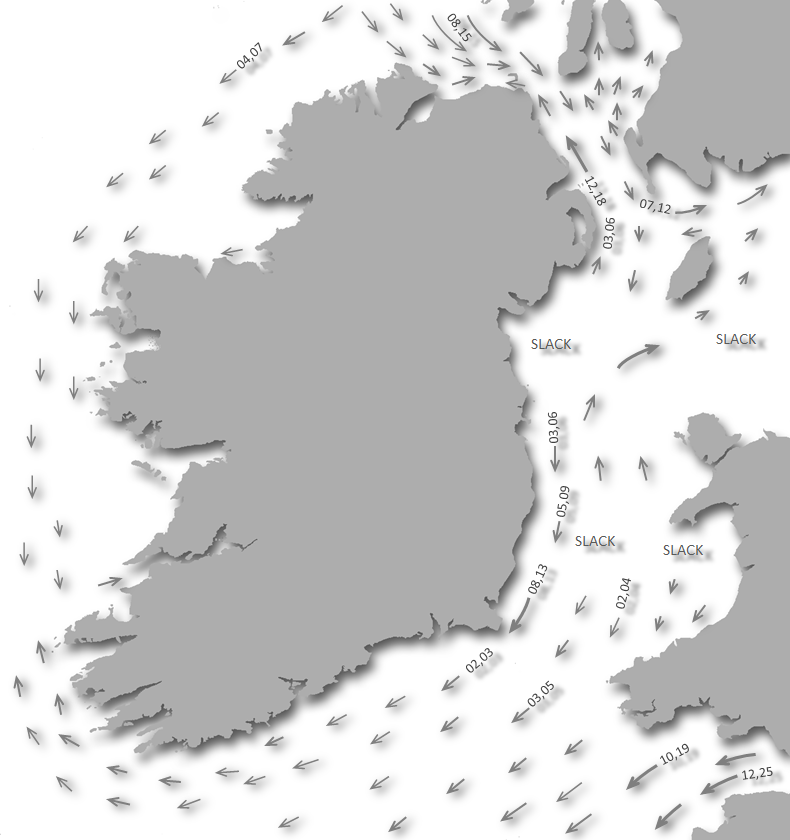
Tolerable shelter can be found at the anchorage to the north of Rusheen Island from the south round through west to north. Access is straightforward in settled conditions in daylight at any stage of the tide.
Keyfacts for Inishkea Island South
Facilities


Nature







Considerations


Protected sectors
Approaches


Shelter


Last modified
March 5th 2020 Summary* Restrictions apply
A tolerable location with straightforward access.Facilities


Nature







Considerations


Position and approaches
Expand to new tab or fullscreen
Haven position
 54° 7.278' N, 010° 12.049' W
54° 7.278' N, 010° 12.049' Wthis is the position at the anchorage in the bay north of Rusheen islet.
What is the initial fix?
The following Inishkea Islands initial fix. will set up a final approach:
 54° 3.299' N, 010° 13.920' W
54° 3.299' N, 010° 13.920' W What are the key points of the approach?
Offshore details are available in Western Ireland’s coastal overview from Slyne Head to Erris Head  .
.
 .
. Not what you need?
Click the 'Next' and 'Previous' buttons to progress through neighbouring havens in a coastal 'clockwise' or 'anti-clockwise' sequence. Below are the ten nearest havens to Inishkea Island South for your convenience.
Ten nearest havens by straight line charted distance and bearing:
- Blacksod Pier - 5.1 nautical miles ESE
- Elly Bay - 5.2 nautical miles ENE
- Frenchport (Portnafrankagh) - 8.3 nautical miles NNE
- Keem Bay - 9.4 nautical miles S
- Keel Bay - 10.1 nautical miles SSE
- Broadhaven Bay - 13.5 nautical miles NE
- Ross Port - 17 nautical miles NE
- Portacloy Bay - 19.5 nautical miles NE
- Porturlin Bay - 21 nautical miles NE
- Clare Island - 21.2 nautical miles SSE
These havens are ordered by straight line charted distance and bearing, and can be reordered by compass direction or coastal sequence:
- Blacksod Pier - 5.1 miles ESE
- Elly Bay - 5.2 miles ENE
- Frenchport (Portnafrankagh) - 8.3 miles NNE
- Keem Bay - 9.4 miles S
- Keel Bay - 10.1 miles SSE
- Broadhaven Bay - 13.5 miles NE
- Ross Port - 17 miles NE
- Portacloy Bay - 19.5 miles NE
- Porturlin Bay - 21 miles NE
- Clare Island - 21.2 miles SSE
Chart
What's the story here?
 Killary Harbour Inishkea South
Killary Harbour Inishkea SouthImage: Gareth Wray
The Inishkea Islands lie almost parallel to and within 2 miles of the western side of Mullet Peninsula. The group consists of Inishkea South and Inishkea North, separated by a narrow channel, and numerous rocks and shoals. At the inner end of which, and on the north side of Rusheen Island, there is anchorage for small vessels in fine weather, but the holding ground is not good. A small quay lies on the northeastern extremity of Inishkea South near the deserted village and protected by Rusheen Island.
The best protection can be found in the anchorage to the north of Rusheen Island. It is also possible to anchor off the small quay.
How to get in?
 Use western Ireland’s coastal overview from Slyne Head to Erris Head
Use western Ireland’s coastal overview from Slyne Head to Erris Head  for approaches. Blacksod Bay is entered between the southern extremity of Mullet Peninsula and Achill Island 4 miles east by southeast.
for approaches. Blacksod Bay is entered between the southern extremity of Mullet Peninsula and Achill Island 4 miles east by southeast.Inishkea South can be positively identified by a rounded grassy hill, 66 metres high, with two white beacons, a flagstaff, and a chimney on its summit. The island is separated from a group of above-water rocks which lie within ½ mile of its southern end by a narrow deep channel. But this channel should be used only by vessels with local knowledge.
 Vessels approaching from the south should give Turduvillaun in order to avoid the dangers off its western side.
Vessels approaching from the south should give Turduvillaun in order to avoid the dangers off its western side. Vessels approaching from the north should keep clear of Inishkea North, and the other island of the group, that are surrounded by foul ground on all except its steep-to western side. The primary danger for the anchorage is Pluddany Rock. This is a dangerous drying ledge that extends about 1,100 metres eastward from the southeastern end of Inishkea North. Vessels approaching from the north may use the alignment of 198° T of Turduvillaun, the little western hummocky islet off Duvillaun More, and the Ears of Achill, 5¾ miles farther along south-by-southwest, as best seen on Admiralty Chart 2704 to pass 300 metres clear Pluddany Rock.
Vessels approaching from the north should keep clear of Inishkea North, and the other island of the group, that are surrounded by foul ground on all except its steep-to western side. The primary danger for the anchorage is Pluddany Rock. This is a dangerous drying ledge that extends about 1,100 metres eastward from the southeastern end of Inishkea North. Vessels approaching from the north may use the alignment of 198° T of Turduvillaun, the little western hummocky islet off Duvillaun More, and the Ears of Achill, 5¾ miles farther along south-by-southwest, as best seen on Admiralty Chart 2704 to pass 300 metres clear Pluddany Rock. The currents set through the above channels at a maximum rate of about 2 knots at springs.
 Yacht anchored off the pier
Yacht anchored off the pierImage: © cpobyrne
 Anchor according to draft to the north of Rusheen Island or, conditions permitting, to the southwest of the island off of the pier.
Anchor according to draft to the north of Rusheen Island or, conditions permitting, to the southwest of the island off of the pier. The best spot for a beach landing is in the rounded bay in the southeast below the abandoned village, but there are other spots at various beaches around the island and one just short of the northern tip is where a seal colony resides.
Why visit here?
The name Inishkea Islands in Irish Gaelic is Inis Ge meaning islands of the geese, but it is thought that originally the name was for Naomh Geidh or Saint Ge. Inishkea South's deserted village
Inishkea South's deserted villageImage: Aiden Clarke via CC BY 2.0
 Cultivation ridges still visible on an Inishkea South hill
Cultivation ridges still visible on an Inishkea South hillImage: Aiden Clarke via CC BY 2.0
The disaster of 1927 dealt a major blow to the Inishkea's and their neighbouring islands. Late October was marked by strong and persistent southwesterly winds, but on the afternoon of the 28th, it was calm enough for herring boats to put to sea from several ports. However, an intense secondary depression then swept through, producing strong southeasterlies quickly veering north-west and strengthening to severe gale force with steep and confused seas. Many of the boats which were under oars or sail, foundered or were swept helplessly ashore. Forty-four young fishermen lost their lives, of which ten were from the Inishkea's, and fishing is a family business many were related. The communities never recovered and shortly after in the early 1930's the inhabitants of both North and South Inishkea left the islands.
Today the islands are mainly used for grazing and are a major breeding ground for Atlantic seals and colonies of sea birds. The derelict cottages still stand, some of them being renovated for holiday homes, or as summer fishing bases. The islands are little known outside the local area but are well known by fishermen who regularly use the island's harbour.
 Old dry stone walls leading up from the harbour
Old dry stone walls leading up from the harbourImage: Aiden Clarke via CC BY 2.0
The south island is perhaps the more attractive and has the advantage of a sheltered beach landing-place below the ruins of the abandoned village beside a stone pier. Good reliable water can usually be had in a small well 100 metres south of the pier just above the first beach where the sand meets the grass. There are no other facilities available.
The north island is separated from the South by a narrow sound, and its most visible feature is a huge burial mound just east of the old village at the southeastern tip, its humpbacked shape is dominant from most angles. The dead of both islands were buried on the north island.
 Standing stone on Inishkea South
Standing stone on Inishkea SouthImage: Tourism Ireland
From a boating point of view these are outstandingly beautiful and pleasant islands, not to be missed if sailing in the area.
What facilities are available?
There are no facilties available at this location.With thanks to:
Michael Harpur eOceanic.Kayaking trip around the Iniskeas and the Duvillauns.
Add your review or comment:
Please log in to leave a review of this haven.
Please note eOceanic makes no guarantee of the validity of this information, we have not visited this haven and do not have first-hand experience to qualify the data. Although the contributors are vetted by peer review as practised authorities, they are in no way, whatsoever, responsible for the accuracy of their contributions. It is essential that you thoroughly check the accuracy and suitability for your vessel of any waypoints offered in any context plus the precision of your GPS. Any data provided on this page is entirely used at your own risk and you must read our legal page if you view data on this site. Free to use sea charts courtesy of Navionics.











 Mullet Peninsula left with the Inishkeas seen offshore
Mullet Peninsula left with the Inishkeas seen offshore 
